Mercury 7 Astronauts Glenn, Carpenter Wow Crowd
by ANN Correspondent Aleta Vinas
Things were a bit more than 'business as usual' this past
weekend at Florida's Kennedy Space Center. KSC played host for the
World Space Expo, a combined celebration of 50 years in space, the
60th anniversary of the Air Force and NASA's almost 50th
anniversary (October 1, 1958).

Pavilions were set up in the Rocket Garden showcasing the new
era of commercial space travel with exhibitors such as SpaceX, the
X-Prize Foundation, The Coalition for Space Exploration and
others.
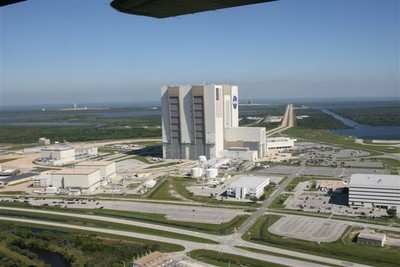
An Aerial Salute to 50 Years in Space highlighted Saturday and
Sunday with performances by The Army Golden Knights parachute Team,
though high winds on Saturday cut the team to one lone courageous
jumper, US Air Force 920th Rescue Wing (with ANN's Jim Campbell and
Alex Manning literally sitting on the back ramp, feet hanging in
the 'breeze', of the HC-130 as it flew over the Cape and then
tanked up two USAF Pavehawks...what a view!), the wing responsible
for Mercury and Gemini capsule recovery, the F-15 Eagle, F-18 Super
Hornet, The US Air Force Thunderbirds and the F-22 Raptor. A
Heritage flight included the F22, F15 and a P-51 Mustang to end the
air show.
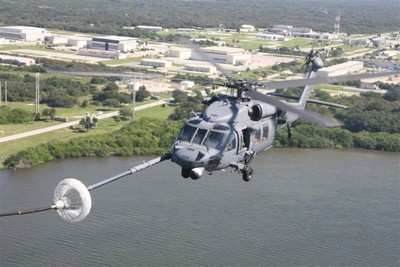
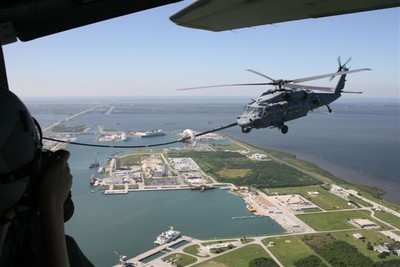
Several talks were scheduled throughout the weekend with
Thunderbird pilots, Shuttle astronauts, speakers from the
commercial space world and Brigadier General Susan Helms, former
shuttle astronaut and current Commander, 45th Space Wing, and
Director, Eastern Range, Patrick Air Force Base scheduled to speak.
There was one panel scheduled that no one wanted to miss with
Mercury astronauts Scott Carpenter and John Glenn.
Scott Carpenter was selected as one of the Mercury 7 in 1959. He
flew Mercury/Atlas 7 on May 24, 1962 and orbited the Earth 3 times
in his capsule Aurora 7. He was back-up for Glenn's Mercury/Atlas 6
flight.
John Glenn was also one of the Mercury 7. Glenn flew the 1st
manned orbital flight in Mercury/Atlas 6. He orbited the Earth 3
times on February 20, 1962 in Friendship 7. Glenn flew again on the
space shuttle mission STS-95 on October 29 - November 7, 1998.
Both men spoke a little about their space experiences and the
atmosphere at this time.
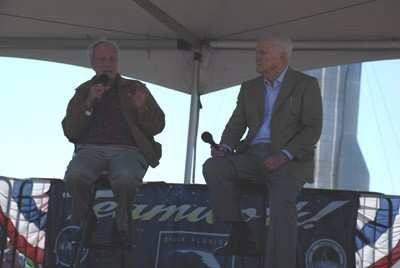
According to Glenn, "Sputnik galvanized this whole country." The
Cold War was on and Russia was not only claiming but proving their
technical superiority by launching boosters -- while "ours, too
often, were blowing up on the launch pad," he said.
Glenn applauded President Eisenhower's decision to allow the US
Space program to be completely open for the world to share. That
openness continues through this day, Glenn added, though does hope
for "a resurgence of emphasis on research."
Carpenter admits that the competition with Russia drove us. He
sees competition as a positive and feels that we need competition
again, partially to increase public interest once more. Carpenter
notes "China lurks. We can use that competition, it will stir us
onward."
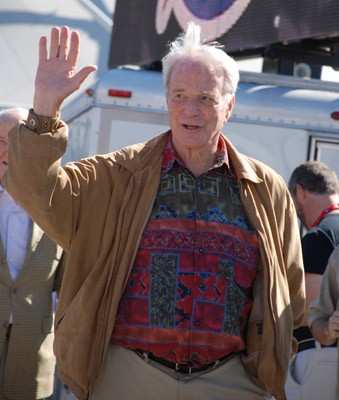
Before deferring to some audience questions, Glenn mentioned
that he and Carpenter were the last two left of the seven. He
teased about always lining up in alphabetical order to which
Carpenter replied "And I love that because I come first." On a
serious note Glenn said "I'm very mindful of all the contributions
that these people made and wish that they could be with us
today."
The first question was regarding 'Fireflies.' Glenn gave a
report on seeing bright objects outside his window -- a window the
astronauts fought to have put in, by the way -- and called these
moisture particles "fireflies". NASA psychiatrist Dr. George Ruff
said to Glenn "What did they say, John?"
The next question was what their greatest achievement was. The
answers were simple and to the point; Carpenter said "Space
flight." Glenn said "marrying Annie" at which point thunderous
applause broke out of the crowd.

Glenn was asked to compare his Mercury flight and shuttle
flight. "Back in those days," started Glenn, "we were just trying
to get a flight off to make sure we could do these things."
Everything about space flight was an unknown at that point;
ophthalmologists worried about deteriorating vision. To that end,
if you visit the National Air and Space Museum you can see an eye
chart on top of Friendship 7's instrument panel. Glenn was to read
it every 20 minutes to be sure his vision was unimpaired. Doctors
worried about the fluid in the inner ear moving around more perhaps
causing vertigo or nausea.
Glenn's shuttle flight was about basic fundamental research --
plus there was more "space" on the shuttle. Glenn also mentioned
the danger, saying "the attitude toward the danger perhaps has
changed a lot. Ask Annie, the first flight she lost 12 pounds the
second flight she gained 12 pounds."
Carpenter teased Glenn about his shuttle flight, "John was
interested in investigating the difference in the response to his
older body to zero G stresses and compare it with his response to
the Mercury flight. I told him that when I'd heard he'd been
selected for this, that I'd be happy to be his stand-by again but
NASA probably wouldn't approve that because I wasn't old
enough."
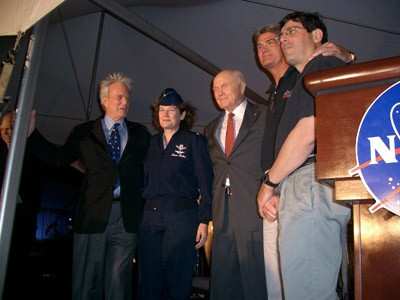
Glenn acknowledged he would like to see more 75–80 year
old adventurers going up on shuttle flights for study, as the
database right now is limited. "N=1" says Glenn, "and I'm the
one."
The two astronauts were asked when they said "what the heck am I
doing here?" Carpenter recognized he'd ask himself that question
when he was fatigued. Once he'd had some sleep, Carpenter was back
on track.
Glenn believes all the men asked themselves that very question,
since space flight was so new and untried. There were thoughts of
possibly losing people. "You had doubts but it was important for
the country and we went ahead and did it and that was that."
When asked their opinion of the Atlas rocket, Glenn recounts
their first experience. Each astronaut had a specialty area and
Deke Slayton followed the Atlas. During the first two dozen or so
launches there was a 45% failure rate. The Atlas has no frame; it
was a "steel balloon", pressure had to be maintained within it to
keep it standing up straight. The seven astronauts were brought
down for a night Atlas launch, their first time seeing the rocket.
It blew up at about 27,000 feet. There was an immediate meeting
with the engineers the next day.
The problem was, of course, fixed -- and Carpenter points out
"100% success in manned flight, four launches, four successes."

The inevitable question about "The Right Stuff" came up. Glenn
was less than complimentary to the movie, while Carpenter felt the
important details covered by Wolfe were accurately portrayed. The
movie, Carpenter felt, was more of a docudrama than
documentary.
Both men do agree on the excellence of "Apollo 13." Says Glenn
"Apollo 13 is exactly the way it happened."
Glenn's two missions both had their cliff hangers. During the
Mercury flight, there was a heat shield issue, and then on the
Discovery shuttle flight the door to the parachute compartment fell
off during launch.
Glenn was asked how you press on and concentrate on the task at
hand. "Train and train and train for everything you can possibly
foresee," he said.
Glenn joked at the standard answer given when people ask if
they're afraid during launch. "How do you think you'd feel if you
knew you were on top of two million parts built by the lowest
bidder on a government contract?"
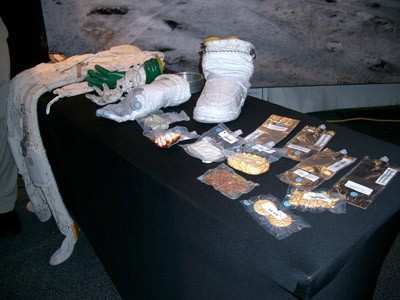
Carpenter acknowledged the accomplishments that were being
observed over the weekend. "We celebrate marvelous achievements, I
hear a voice underneath that celebration, soft and prophetic saying
‘wait, cause you ain't seen nothing yet'."
 ANN's Daily Aero-Linx (04.16.24)
ANN's Daily Aero-Linx (04.16.24) Aero-News: Quote of the Day (04.16.24)
Aero-News: Quote of the Day (04.16.24) Airborne 04.10.24: SnF24!, A50 Heritage Reveal, HeliCycle!, Montaer MC-01
Airborne 04.10.24: SnF24!, A50 Heritage Reveal, HeliCycle!, Montaer MC-01 Airborne 04.12.24: SnF24!, G100UL Is Here, Holy Micro, Plane Tags
Airborne 04.12.24: SnF24!, G100UL Is Here, Holy Micro, Plane Tags Airborne-Flight Training 04.17.24: Feds Need Controllers, Spirit Delay, Redbird
Airborne-Flight Training 04.17.24: Feds Need Controllers, Spirit Delay, Redbird












